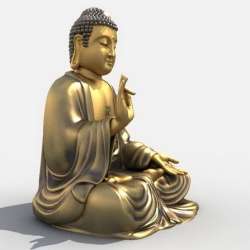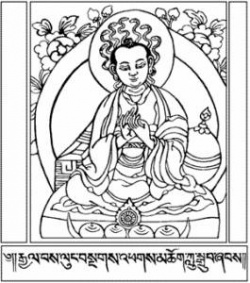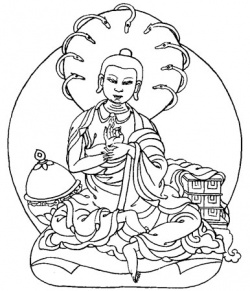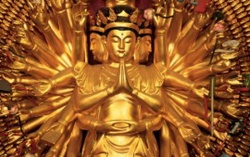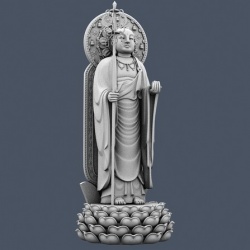Thinking in Buddhism: Nagarjuna's Middle Way by Jonah Winters
Jump to navigation
Jump to search
- by Jonah Winters
- The Buddha and His Teachings
- Siddhartha Gautama, the sage of the Sakya clan, founded a religion that is in many ways the most anomalous of those surviving in the world today. He claimed access to no divine wisdom, no unique intuition, no worldly or spiritual authority, and no super-human status of any kind. The philosophy he taught subverts common-sense notions about what the nature of the world is and uproots the very beliefs that people tend to cherish the most: the existence of God, the reality of the self, the promise of an afterlife, and the availability of happiness. In their place he taught reliance on personal understanding and the pragmatic uselessness of mere belief.
- He taught that all phenomena are impermanent and nothing can be counted on to endure; that there is no soul to be found at any time, in any thing, anywhere; and that the fundamental quality of life, even when it seems pleasant, is radically unsatisfactory.
- And yet, the religion that has grown out of Gautama's teachings has become a major world religion known for its equanimity, its compassion, and, even, its joy.
- Gautama was born in northeastern India in what is modern day Nepal in either 566 or 448 BE. and died eighty years later.
- Note: For a full discussion of the Buddha's dates, see Etienne Lamotte, History of Indian Buddhism, trans. Sara Webb-Boin (Louvain-La-Neuve: Institut Orientaliste, 1988), 13-14
- Gautama's father Suddhodana was a minor king, the head of the Sakyas. Legend holds that Gautama was so remarkable as a child that soothsayers predicted that he would one day become either a universal monarch or an "awakened one," a "Buddha."
- Note: The following biography of the Buddha is culled from a variety of sources. The scriptural accounts of his life vary, and so this often-imaginative biography is not to be taken as authoritative.
- Suddhodana wanted his son to be the next head of the clan, and so did everything in his power to keep him attached to the world and oblivious of things spiritual. Gautama was provided with fine clothing, expensive perfumes, courtyard gardens and lily pools, and all worldly delights, and was attended by female musicians in three palaces, one for each season. Strict orders were given that he was not to be exposed to any uglinesses or unpleasantries. He married a neighboring princess, Yasodhara, at age sixteen, and they had a son, Rahula, when he was twenty-nine.
- Legend relates that one day, shortly after the birth of Rahula, Gautama requested to see the city that he had never before seen. Unable to dissuade him, his father had runners clear the streets of all unpleasant sights and then allowed Gautama to be taken out in a chariot. Serendipitously, or, as some legends hold, at the will of the far-seeing God, the young prince was exposed to four shocking sights which the runners had missed.
- First, Gautama saw a decrepit man, gray-haired, broken-toothed, and bent with age, by the side of the road. Since he had seen few humans other than his family and his 40,000 dancing girls, he asked his charioteer in astonishment what sort of creature the man was. That is what happens when people get old, explained the driver.
- The next day, the prince asked to go out again. Though his father doubled his efforts to clear the streets of all unpleasant sights, a sick person was missed. On seeing the person lying by the side of the road, racked with disease, Gautama again turned to his charioteer in surprise. That is illness, he was told.
- The following day he embarked on another tour on which he was exposed to the sight of a human corpse, and thus learned of the fact of death. Legend or not, this story portrays an important element of the Buddha's later teachings: while the facts of age, sickness, and death are known to us, it is still easy to forget them, and a direct confrontation with their reality is often a novel and disturbing insight.
- Note: Harvey, 18
- Unless one is aware of suffering, one will never seek to improve one's condition, a fact of which the Buddha was to make much use.
- The prince made one more excursion into the city the next day, and, again, he was exposed to something he had never before seen — - a saffron- robed renunciant with a shaven head, a begging bowl, and, most importantly, a tranquil and serene demeanor. That night, after returning to his palace, he realized that all of his previous pleasures were now but hollow delights. He waited until Yasodhara and Rahula were asleep, took one last look at his son lying in his wife's arms, kissed them both, and left. Such an exit was seen by some of the later writings as setting a precedent for the renunciant monastic disciplines the Buddha later organized, and the seeming callousness of it is mitigated by the claim that he had to leave his family for the future benefit of all beings, that is, so that he could attain his enlightenment and then teach it to others.
- Note: ibid., 18
- It is also pointed out that he was clearly not abandoning his family, for his son later became one of his greatest disciples. However, the sense of solitude, spiritual desperation, and determination portrayed by this episode is not lessened.
- It was with such a sense of determination that Gautama embarked on the next stage of his life. He had seen the suffering from which he had been sheltered for so long, and then he had seen proof in the form of the renunciant that such suffering can be conquered. He now set himself the goal of learning how to conquer it. He saw that his many years of living in opulence had not taught him the way to enlightenment, so he now tried the opposite path. For six years he practiced renunciation and asceticism. He first practiced raja yoga in an attempt to conquer suffering through meditation and the control of consciousness. Gautama soon surpassed his teachers by attaining states of elevated awareness higher than the ones of which they were capable, but did not feel that he had reached his goal yet. He left his yoga teachers and joined a group of ascetics to practice rigorous physical austerities. His strong sense of determination led him to practice self-mortifications so severe that he nearly died.
- By the time he could barely stand up and all of his hair had fallen out, Gautama realized that asceticism was not going to bring him to his goal, either. He recollected that he had once spontaneously experienced a certain meditative state that could provide a path to awakening, and decided to give it one last try. He took food, left the group of ascetics, and sat under a tree, determined to gain enlightenment or die. As he began to meditate, the legendary demon tempter, Mara, assailed him first with visions of beautiful women and then with violent storms in an attempt to prevent Gautama's immanent enlightenment. Gautama ignored Mara and entered deeper into meditation. He passed through state after state of consciousness until he achieved the enlightenment he had so long sought, nirvana. He was now a "Buddha," an "awakened" one. Reflecting on what he had found, he saw himself as presented with a difficult choice, which is sometimes portrayed as being Mara's final assault. He could either selfishly enter parinirvana, the state of "nonreturning" liberation, or he could postpone the final, ultimate freedom and return to the world to teach. The latter option seemed pointless, for the awakening that he had experienced was so profound, so subtle, and so "beyond the sphere of reason" that he feared it would be pointless to try to teach it to anyone else. The deciding factor was the Buddha's enlightened insight into the oneness of all beings, which led him to sympathize with the suffering of others. He felt compassion and realized that he must return, even if for the sake of only one person's understanding. Thus began the ministry of the Buddha.
- The biographies in the canonical texts, the sutras, give only sparse information of the Buddha's life following his nirvana. A likely explanation for the greater emphasis on his earlier life than on his later is that the core teaching of the Buddha is the "path" to follow, the process one must go through to realize nirvana for oneself. Thus, the Buddha's personal search for awakening is more important than what he did after he had found his goal. The general picture conveyed by the few details available is that he spent the rest of his life wandering around the Ganges basin area on foot, with few possessions, teaching his ever-growing group of disciples. Much of his teaching method would have been seen as subversive by the society around him. He taught in the local languages and dialects, spurning the Sanskrit which by this time was already associated exclusively with the educated, elite priestly caste of Hinduism.
- He taught with no distinction, associating with all classes and castes of men and women.
- He also shunned both the isolation of the forest and the community of the cities, preferring to reside and teach in the outskirts of the urban areas. After wandering and teaching for forty-five years, the Buddha prepared for his death. He asked his followers if they had any last questions. When no one spoke, he told them "All conditioned things are impermanent. Work out your salvation with diligence!" and entered parinirvana, the final liberation.
- Note: Maha-Parnibbana-Sutta in T.W. Rhys- Davids, trans., Buddhist Suttas (New York: Dover Publications, Inc., 1969), VI.1
- The philosophical system that the Buddha taught is remarkably clear and simple. It would, however, be very easy for a presentation of his thought to degenerate into hundreds of pages of confusion and nonsense, and it could be argued that much of the history and doctrinal development of Buddhism has been just such an endeavor of obfuscation. His teaching is simple in that it can be summed up in two words: the keyword of his philosophy is "impermanence" (anitya) and the keyword of his religion is the "path".
- Note: The question of whether or not Buddhism is a religion will not be considered here. For purposes of this discussion, "philosophy" will be taken to mean the intellectual explanation of reality, and "religion" will be taken to mean the quest for salvation. Further discussion of this question can be found in Regington Rajapakse, "Buddhism as Religion and Philosophy," Religion 16 (January, 1986): 51-56
- All elements of the Buddha's teachings fall out from these two concepts. The purpose of the Buddha's teachings is to bring people to their own enlightenment by means of the "Noble Eightfold Path," the prescriptions for living the "noble" and beneficent life. Thus, while his philosophy is the subject of this thesis, a brief presentation of his soteriological teachings will be apposite here. The key to the moral life is following the "middle way" between extremes. The Buddha had attained enlightenment by renouncing the two extremes of worldliness and world-renunciation. Neither his twenty-nine years of living in luxury nor his six years of living in self-denial had led him to his goal; it was only after he abandoned such extremes that his search came to an end. The first sermon the Buddha delivered after his enlightenment opened with an admonition to give up both the seeking after pleasure and the practice of asceticism. The correct way to lead a proper life, he taught his first audience, is "the middle path, …a path which opens the eye, and bestows understanding, which leads to peace of mind," and eventually to nirvana.
- Note: Dhamma-Cakka- Ppavattana-Sutta 3 in Rhys-Davids
- The significance of following the middle way is greater than merely the renouncing of the two extremes of hedonism and asceticism: the middle way is the principle which infuses the entire corpus of moral teachings of Buddhism.
- Note: Whether or not, and in what way, such "middle-ism" also defines Buddhist philosophy will be discussed in chapters four and five.
- Buddhism is primarily a path, not a philosophy. As has been aptly stated, Buddhists often insist "If you wish to understand the Buddha's doctrine, you must practice it!"
- Note: Geoffrey Parrinder, ed., World Religions (New York: Facts on File Publications, 1983), 271 (italics in original)
- The Buddha likened the human situation to a man who has just been shot with a poisoned arrow by an unknown assailant. If the man refuses to have the arrow removed until he finds out who shot him, what caste the assailant is from, what color his skin is, how tall he is, what kind of bow he used, and what types of feathers were on the arrow, that man will die. The important thing for the man to do is to remove the arrow. The arrow in the side of humanity is afflicted existence, duhkha. The poison on the arrow is the cause of duhkha, which cause is craving. The way to remove the arrow of duhkha and the poison of craving is by following the Buddha's path and teachings, the Dharma.
- Note: The complete parable can be found in Henry Clarke Warren, ed. and trans., Buddhism in Translations (Delhi: Motilal Banarsidass, 1987), 117-122
- Duhkha cannot be satisfactorily translated into English. It conveys the sense of the words "evil," "unsatisfactoriness," "unpleasantness," "imperfection," and "disease." The most felicitous single translation is "suffering." Even if not exact, this is the term encountered most commonly in translations. The fact of suffering constitutes the first of the Buddha's four "Noble Truths." All things that are temporary and conditioned are suffering, duhkha. Encounters with unpleasant things are, of course, suffering, but even pleasant things are suffering because of the fact that, being conditioned, they are subject to ending.
- Note: It may be important to introduce here the concept of conditionality, for it is a concept that will surface again and again in the following thesis. Briefly, a thing is conditioned if it arose depending on a cause, such as a sprout arises depending on the existence of the seed, or if it exists depending on a ground of support, as fire exists depending on the fuel it is burning. A thing is also called "conditioned" if it depends on something else for its differentiation and definition, as "shortness" only exists in relation to "longness." Only something which is uncaused and has an autonomous identity can be unconditioned.
- The cause of suffering is the second Noble Truth. Suffering is occasioned by desire, be it the thirst for pleasure or the craving for existence itself. This desire, having impermanent things as its object, will always be frustrated because it can never be satisfactorily fulfilled. The third Noble Truth is that it is possible to put an end to such desire and thus rid oneself of suffering. Ridding oneself of suffering occurs when one realizes the nonreality of existence in a peculiar state known as nirvana, or freedom. Thus far, the Buddha presented an analysis of the human experience which states that all existence is inherently unpleasant due to its impermanency, that the reason we find impermanent phenomena to be unpleasant is because we entertain desires and cravings which cannot be satisfied by ephemeral things, and that the key to finding satisfaction is to put an end to such desires.
- The fourth and final Noble Truth is that there is a method available to us by which we can appease desires and thus attain nirvana. This way is presented as the Eightfold Path. The path is a systematized guide for living which will enable one to curtail attachment to transitory things and to train oneself in proper modes of thought and behavior to eventually achieve liberation. The eight limbs of the path prescribe behavior which is "samyak." "Samyak" will here be translated as "right," but it also carries the overtones of "complete" and "perfect."
- Note: cf. Sir Monier Monier-Williams, ed., A Sanskrit-English Dictionary (Delhi: Motilal Banarsidass, 1993), 1181
- A fuller understanding of "samyak" can be had by keeping in mind the importance of "middle-ism" as described above. Renouncing all behavioral extremes leads to a comportment that could best be described as "moderate;" observing moderation in all actions and thoughts and desires will lead, not just to proper behavior, but also to the very enlightenment which is the goal of Buddhism.
- The Eightfold Path opens with two guidelines for perfecting wisdom, namely right (samyak) views and right thought. Personal apprehension of the Buddha's teaching, his Dharma (henceforth translated as "Law"), is an essential aspect of accepting the Law and proceeding on the path. This understanding must be translated into right thought, the attitudes of the individual towards the rest of the world. Right thoughts are selflessness, compassion, and non- violence. This is followed by three guidelines for morality, namely right speech, right conduct, and right livelihood. The moral life is not required merely for reasons of compassion for others; appeasing the desires that cause one to suffer will be accomplished in large part by leading a life free from egocentricity, greed, and selfish goals. The final three steps on the path, right effort, right mindfulness, and right concentration, detail the spiritual ascesis without which the attainment of nirvana would be impossible. Right effort and mindfulness prescribe the importance of being focused on the goal of liberation, and avoiding all things which would be karmically unwholesome. Right concentration, samadhi, is that drive of pointed meditation which allows for liberation, the final abandonment of all desires and the attainment of alert equanimity and bliss.
- The philosophy of the Buddha rests on one simple observation: all things are impermanent (anitya). Impermanence is the first of three fundamental marks of existent things, and from it follow the other two: suffering, and "soul-less-ness." Transitorinessis the fundamental property of all existent things, for all things come into being, persist for a time, and then pass out of being again. Without such impermanence, no change would be possible, and thus neither would liberation be possible. That is, it is the susceptibility of all things to change that allows one the option of controlling one's life and following the Eightfold Path. The Buddha's emphasis on the reality of impermanence should not be seen as a doctrinal dogma as much as a simple perception. Not only is continual flux perceptible to all who have insight, but, moreover, a balance in reality requires that any thing which comes into existence must also, some day, go out of existence.
- Note: The use of the problematic term "reality must be explained. That signified by "reality" is usually taken to be the real, i.e. that which exists. Here, it will occasionally be used to refer to the cosmos as a whole, to the entirety of nature, yet without expressly signifying "existence. For lack of a better term, the reader is asked to accept that "reality," used here, is not necessarily meant to imply existence as such, and the meaning of the term will vary according to context.
- The significance of impermanence is beautifully expressed by the parable of the conversion to Buddhism of the two friends Sariputta and Moggallana. Seeking enlightenment and having found it nowhere, they made the pact that they would split up and whoever should first realize nirvana would come and teach the other. Sariputta went his way, and encountered a saintly monk, placid of disposition and perfect of deportment. What is your secret, brother? asked Sariputta. Whom do you follow, and what is the truth you have found? The monk replied that he was but a novice and a new-comer to the doctrine that he had found, and so could not expound the doctrine or describe its teacher. He could, however, offer to Sariputta this tidbit of the teaching: all things that arise will cease, said the monk. On hearing this, Sariputta suddenly understood, clearly and distinctly, the noble doctrine, and became enlightened. He returned to his friend Moggallana who, upon seeing Sariputta from afar, immediately perceived that a profound change had come over his friend. What is the truth you have found? asked Moggallana. I don't know the doctrine or its teacher, replied Sariputta, but I can tell you this: all things that arise will cease. On hearing this, Moggallana, too, became enlightened.
- Note: Warren, 87-89
- A refusal to accept transitoriness is the cause of suffering, as briefly discussed above. A perception of such impermanence and of suffering, its corollary, is the key to liberation. Humans tend to desire, and desires do not exist in a vacuum — -they are always desires for something, and if the object of the desire is subject to flux, then the desire will, sooner or later, be frustrated. The third mark of existence is also a direct corollary of impermanence: there is no permanent, abiding, unchanging soul, atman, to be found in any existent thing. This is perhaps the most revolutionary of all elements of the Buddha's philosophy, for his time period was one of great emphasis on the reality of the soul in the dominant zeitgeist of India, Hinduism.
- Note: Rahula, 55
- The period of the writing of the principal Upanisads had only recently ended, and the orthodox schools of Indian thought were abuzz with theories of the individual soul and its relation to Brahman, the universal soul. By denying the reality of atman, the Buddha was subverting one of the most cherished of all concepts in Indian religion. However, the doctrine of soullessness, anatman, was an inescapable conclusion of the perception of flux; if all existent things are subject to change, then there can be no unchanging essence that exists. And if one tries to escape that conclusion by positing a soul "beyond" the realm of existence, then one arrives at the same answer: the soul does not exist. It is meaningless to posit something that is beyond existence, for it would be in no way real.
- The three marks of existence — -impermanence, suffering, and soullessness — -define the nature and quality of reality as taught by the Buddha. Inquiring into the ultimate cause and purpose of existence and its ontological nature is fruitless. It is not that the answers to such metaphysical questions are beyond human understanding, nor that the answers sought are conceptually inexpressible; it is simply that they are irrelevant. If you do not remove the arrow now, said the Buddha, you will die. One must leave metaphysics alone, for the only thing of importance is to follow the path.
- Note: A usage note is required here. The term "metaphysical" will be encountered often in this thesis, and so a clarification of its meaning is crucial. Metaphysics must not be understood as pertaining to the study of the supernatural, the mystical, or the New Age movement; this is a very recent use of the word. Metaphysics is the branch of rational philosophy that examines the nature of reality, especially the relationships between mind and matter and substance and attribute. This includes the connotational meaning of a priori speculation upon questions that are unverifiable by observation, analysis, or experimentation.
- Notwithstanding, the Buddha was in no way misologistic. That he did not scorn the use of reason and philosophy is demonstrated by the fact that the first two limbs of the Eightfold Path are right views and right thought. He offered a positive metaphysics by presenting a complete teaching of causation known as the theory of pratitya-samutpada, "interdependent origination," or "dependent arising." As a teaching of the nature of all existent things, dependent arising is a comprehensive philosophy which explains the origin of perception, the essence of the individual, the workings of karma, and the nature of previous, present, and future lives. Dependent arising is an extremely lucid and rational explanation of the nature of all existent things, but not one that is easy to understand without a great deal of reflection. The following explication of dependent arising is thus not intended to be an explanation as much as a brief introduction. (No more than an introduction is necessary here, because the theory will be discussed extensively in chapter five.) Dependent arising, simply, is the principle that all existent things are conditioned and relative by virtue of having come into existence as interrelated phenomena. When this arises, that arises; when this ceases, that ceases, explained the Buddha. Impermanence and its corresponding dictum of soullessness preclude the possibility of there being permanently-enduring or independent and self-subsisting phenomena.
- The "chain" of dependent arising consists of "links" of mutually interacting causes and effects. The root of the chain is ignorance, avidya, on which basis the second link, preferences and dispositions, comes to be. On the basis of these preferences arises the third link, volitional will and consciousness. This consciousness gives birth to the fourth link, the {{Wiki|psychophysical]] individual. The individual then experiences sensory stimulation which creates in him or her desires to have certain sensations and to avoid others, which is a process of the next three more links. On the basis of these desires one develops cravings, link nine, and grasps onto perceived existence itself, link ten. This grasping and clinging to existence is the cause of all suffering, for it leads to the eleventh link, birth and rebirth, which is followed by the final link of old age, disease, and death. The key to enlightenment, or cessation of afflicted existence, is the reversal of the process by which afflicted existence has arisen. One must appease, or let go of, cravings. In order to do this one must seek wisdom, which wisdom will undercut ignorance, the initial cause of the chain.
- Although presented as a linear chain, dependent arising should be understood as a circle, for all of the links of the chain influence all of the other links. It is tempting to look at the ultimate cause of the chain, ignorance, and ask what caused it to come into being, and thus embark upon infinite regress. There are two reasons that this would not be appropriate, one philosophical and the other pragmatic. First, it would not be proper to seek a cause for ignorance avidya), for ignorance is not a positively existing entity. Rather, it is a lack. One does not inquire into the cause of darkness, for darkness is nothing but the lack of light. Second, the "cause" of ignorance is utterly irrelevant for the Buddha's teaching. Ignorance is a deadly poisoned arrow which must be removed; where the arrow came from is not important.
- It is often said that the Buddha was neither a prophet nor simply a teacher, but was a spiritual doctor. His presentation of the four Noble Truths paralleled the practice of medical doctors in his day which was to 1) diagnose a disease, 2) identify its cause, 3) determine whether it is curable, and 4) outline a course of treatment to cure it.
- Note: Harvey, 47
- This was exactly the Buddha's method. All humans are afflicted with the disease of suffering; this disease is caused by ignorance and the cravings which can follow ignorance; this disease is not an unregenerate condition but can be cured; the cure is to follow the Eightfold Path of moderation and understanding, which will lead to enlightenment and freedom.
- The Buddha's teachings may thus far appear simple and straightforward. This may be true, but for one condition. All unenlightened humans, according to the Buddha, are immersed in the mud of ignorance, and are thus incapable of seeing clearly. "Men who are overcome by passions and surrounded by a mass of darkness cannot see this truth," he once thought to himself.
- Note: Source not named: quoted in Rahula, 52
- However, there were also times when he reassured his disciples that his philosophy was inherently difficult to grasp. Speaking to his disciple Vaccha, he said "Profound, O Vaccha, is this doctrine, recondite, and difficult of comprehension, …and it is a hard doctrine for you to learn."
- Note: Majjhima-Nikaya, quoted in Warren, 126
- Whether the difficulty of comprehending the Buddha's teachings is due only to the obscuring passions of humans or whether it is indeed inherently abstruse, the subsequent history of Buddhism demonstrates that the Buddha's teachings were anything but unambiguous to his disciples and later Buddhist thinkers. The varieties of interpretation of the Buddha's thought that have been propounded in the last two-and-a-half millenia bear ample witness to this. It is this diversity of interpretation that was to engender the Madhyamika school six hundred years after the Buddha's death.


